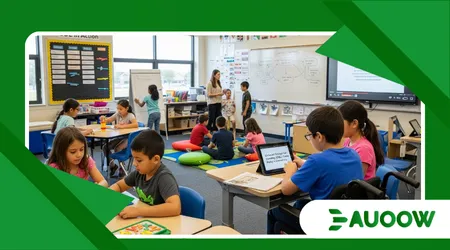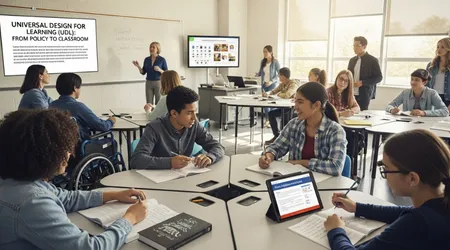Universal Design for Learning (UDL): From Policy to Classroom

Universal Design for Learning (UDL) stands as a modern beacon for educational equity, moving past simple accommodation to proactive inclusion in the classroom.
This framework, rooted in neuroscience, shifts the burden of adjustment from the student to the learning environment itself, demanding flexibility in curriculum design.
By prioritizing the diverse needs and strengths of all students from the outset, Universal Design for Learning (UDL) ensures that barriers to access and engagement are systematically dismantled, not patched up later.
Its implementation is rapidly transitioning from a theoretical ideal into a public policy imperative in jurisdictions worldwide.
Recognizing that “one size fits all” education fails a significant portion of the student population, policymakers are increasingly embedding UDL principles into legislation and curriculum standards.
This is a crucial move that solidifies UDL as a fundamental right to accessible, high-quality learning for everyone.
Why is Proactive Design More Effective Than Reactive Accommodation?
Traditional education models often operate under the flawed assumption of an ‘average’ learner, forcing teachers into reactive measures like retrofitting lessons or granting individual accommodations post-failure.
This approach is inefficient, stigmatizing, and fails to address the systemic issue of inaccessible design. The core of Universal Design for Learning (UDL) is its proactive nature.
Instead of waiting for a student to struggle and then providing a ramp, UDL builds the ramp into the curriculum from the start, making it universally usable.
This philosophy, inspired by architectural universal design, sees learner variability not as a problem to be solved, but as a resource to be optimized through flexible design choices.
++ How Policies Impact Dyslexia and Learning Disabilities in Schools
The Three Pillars: What are the Core Principles of UDL?
The UDL framework is built upon three foundational principles, each targeting a key network of the human brain involved in learning.
These principles ensure flexibility in how students encounter and interact with content, fundamentally changing the learning experience.
The first principle, Multiple Means of Representation, addresses the ‘what’ of learning by ensuring information is presented in various formats, such as audio, visual aids, and text, accommodating different perception and comprehension styles.
The second, Multiple Means of Action and Expression, tackles the ‘how’ of learning, offering diverse ways for students to demonstrate their knowledge, like through written reports, oral presentations, or multimedia projects.
The third pillar, Multiple Means of Engagement, focuses on the ‘why’ of learning the affective or motivational component.
It seeks to tap into varied student interests, provide appropriate levels of challenge, and offer choices that foster self-regulation and sustained effort, making the learning personally relevant.
Also read: Are Students with Disabilities Protected in Higher Education?
Removing the Stigma: Equity in the Learning Process
When accommodations are provided reactively, they often draw attention to the student, creating a feeling of being ‘othered’ or less capable.
Universal Design for Learning (UDL) normalizes options and flexibility for all, subtly eliminating this stigma.
By providing multiple pathways for success to everyone, the focus shifts entirely from perceived student deficits to the power of environmental design.
This inclusive climate fosters a safer, more welcoming classroom environment where all students feel valued and supported in making choices that align with their personal learning strengths.
The resulting boost in self-efficacy and motivation is a profound benefit that transcends academic metrics, nurturing true learner agency.

How Do Public Policies Drive UDL Implementation?
For UDL to move beyond isolated enthusiastic teachers and truly permeate a public education system, robust and clear public policy support is essential.
Legislation must mandate training, allocate resources for technology, and update assessment standards to reflect flexible means of expression.
Without this top-down directive, UDL often remains optional, not universal.
The inclusion of UDL as a guiding framework in major educational legislation, such as the U.S. Every Student Succeeds Act (ESSA), signifies its policy maturation.
This commitment ensures federal and state funding priorities align with the goal of creating inclusive, high-expectations learning environments for every student, regardless of background or ability.
Read more: Latin America’s Emerging Accessibility Policies: Who’s Leading?
Legislative Influence on Curriculum and Technology
Policy initiatives have a direct, tangible effect on the tools and content used daily in classrooms.
When a state department of education adopts UDL guidelines, it compels curriculum developers to build materials that are digitally accessible, customizable, and inherently multimodal. This investment democratizes access to learning resources.
In a major U.S. state, a 2024 policy mandate required all new K-12 digital textbooks to comply with UDL guidelines, necessitating built-in features like text-to-speech, adjustable contrast, and navigable headings.
This shift instantly benefits students with dyslexia, low vision, and English language learners simultaneously, showcasing true universal benefit.
The Impact of Teacher Professional Development Mandates
The effective translation of UDL from policy documents to classroom practice hinges entirely on the preparedness of educators.
Public policies that mandate comprehensive, ongoing professional development focused on UDL implementation are non-negotiable. Teachers need practical, sustained support to reimagine their pedagogy.
A 2024 meta-analysis of UDL implementation studies indicated that teacher training and coaching focusing on the UDL Guidelines led to a significant 35% improvement in teachers’ self-reported ability to reduce classroom barriers after just one year.
This underscores the critical link between policy, training, and effective outcomes.
What are the Measurable Benefits of a UDL Classroom?
The advantages of UDL extend far beyond meeting compliance requirements; they result in clear, measurable academic and behavioral improvements for all learners.
By offering choice and flexibility, UDL inherently increases student engagement, which is a known predictor of academic success.
Is there any clearer metric for a successful education system than empowering all students to become expert learners?
Furthermore, UDL adoption significantly reduces the need for constant, individualized modifications, freeing up specialized staff time.
This increase in efficiency allows school resources to be redirected towards more intensive, targeted interventions for the few students who still require them, optimizing the overall support system.
UDL and Student Agency: The Power of Choice
When students are presented with multiple options for content consumption (reading a text, listening to a podcast, or watching a video) and expression (writing an essay, creating an infographic, or coding an app), they gain a sense of control.
This empowerment, known as student agency, leads to deeper engagement and better metacognitive skills.
The traditional classroom is a landline rigid, singular-purpose, and static.
A UDL classroom is a smartphone flexible, offering countless applications and pathways (representation, action, engagement), allowing the user (student) to customize the tool to meet their specific, ever-changing needs.
Reducing Referrals and Improving Academic Outcomes
Schools that fully embrace the Universal Design for Learning (UDL) framework often report a noticeable decline in referrals for special education services because the ‘disability’ was often simply a mismatch between the rigid curriculum and the student’s learning profile.
When the environment is designed for variability, fewer students are identified as needing special interventions.
| UDL Principle | Classroom Practice | Universal Benefit |
| Representation (The WHAT) | Offering materials in audio, text, and video formats. | Improves access for students with dyslexia and English Language Learners. |
| Action & Expression (The HOW) | Allowing choice between a test, presentation, or project. | Benefits students with executive function challenges and test anxiety. |
| Engagement (The WHY) | Providing choices in project topics or collaboration styles. | Boosts motivation for reluctant learners and promotes cultural relevance. |
The implementation of Universal Design for Learning (UDL) is more than an educational reform; it’s a social justice movement realized in the classroom.
By legislating inclusivity and training educators to embrace design flexibility, public policy transforms the learning landscape.
UDL ensures that every student, celebrated for their unique variability, is given a clear, accessible path to becoming a purposeful, resourceful, and expert learner.
The future of equitable education depends entirely on our commitment to making this universal design a ubiquitous reality.
Share your experience: How has a UDL-inspired choice in the classroom positively impacted your learning or teaching? Let us know in the comments.
Frequently Asked Questions
Is UDL the same as differentiation?
No. Differentiation is reactive, requiring the teacher to modify a lesson for a specific student after the initial design.
Universal Design for Learning (UDL) is proactive, designing flexibility and options for all students from the start, making subsequent differentiation less necessary.
Does UDL only benefit students with disabilities?
Absolutely not. While UDL was originally inspired by the needs of students with disabilities, the flexible design options benefit all learners.
For example, offering a text with an audio version helps students with dyslexia, but also helps busy students, athletes, or commuters engage with content on the go.
Is UDL too expensive to implement in public schools?
Initial costs for professional development and accessible technology upgrades can be a factor, but UDL leads to long-term cost savings.
By reducing the need for costly, time-consuming individual accommodations and decreasing the rate of special education referrals, UDL streamlines resources and maximizes the effectiveness of existing technology, making it a sustainable and cost-effective strategy over time.
Where did the UDL framework originate?
The UDL framework was created and advanced by the Center for Applied Special Technology (CAST), a non-profit education research and development organization in the United States, based on extensive research in the learning sciences and brain networks.
